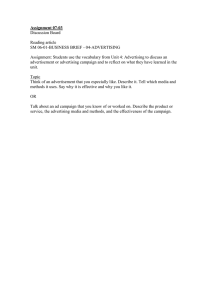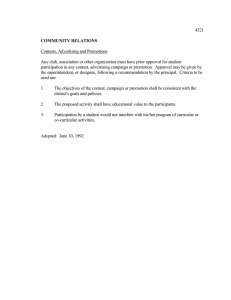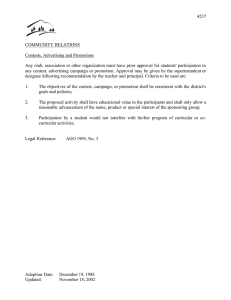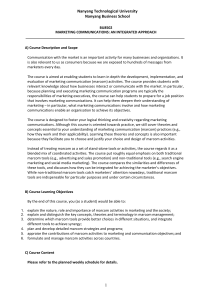Communications Brief Template
advertisement
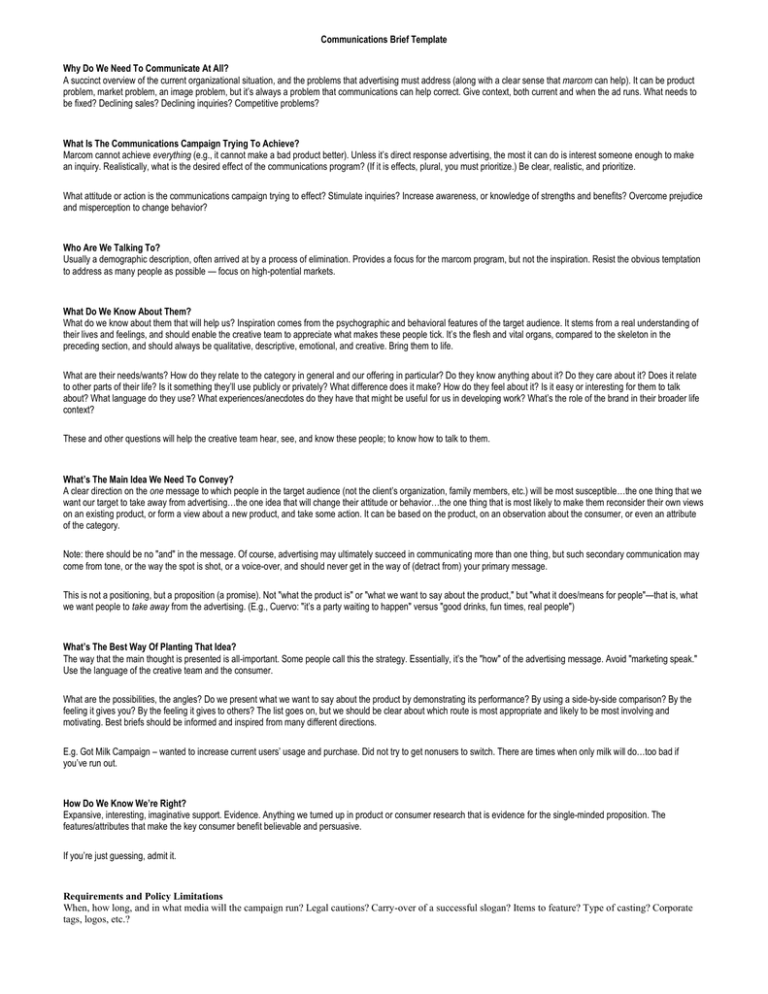
Communications Brief Template Why Do We Need To Communicate At All? A succinct overview of the current organizational situation, and the problems that advertising must address (along with a clear sense that marcom can help). It can be product problem, market problem, an image problem, but it’s always a problem that communications can help correct. Give context, both current and when the ad runs. What needs to be fixed? Declining sales? Declining inquiries? Competitive problems? What Is The Communications Campaign Trying To Achieve? Marcom cannot achieve everything (e.g., it cannot make a bad product better). Unless it’s direct response advertising, the most it can do is interest someone enough to make an inquiry. Realistically, what is the desired effect of the communications program? (If it is effects, plural, you must prioritize.) Be clear, realistic, and prioritize. What attitude or action is the communications campaign trying to effect? Stimulate inquiries? Increase awareness, or knowledge of strengths and benefits? Overcome prejudice and misperception to change behavior? Who Are We Talking To? Usually a demographic description, often arrived at by a process of elimination. Provides a focus for the marcom program, but not the inspiration. Resist the obvious temptation to address as many people as possible — focus on high-potential markets. What Do We Know About Them? What do we know about them that will help us? Inspiration comes from the psychographic and behavioral features of the target audience. It stems from a real understanding of their lives and feelings, and should enable the creative team to appreciate what makes these people tick. It’s the flesh and vital organs, compared to the skeleton in the preceding section, and should always be qualitative, descriptive, emotional, and creative. Bring them to life. What are their needs/wants? How do they relate to the category in general and our offering in particular? Do they know anything about it? Do they care about it? Does it relate to other parts of their life? Is it something they’ll use publicly or privately? What difference does it make? How do they feel about it? Is it easy or interesting for them to talk about? What language do they use? What experiences/anecdotes do they have that might be useful for us in developing work? What’s the role of the brand in their broader life context? These and other questions will help the creative team hear, see, and know these people; to know how to talk to them. What’s The Main Idea We Need To Convey? A clear direction on the one message to which people in the target audience (not the client’s organization, family members, etc.) will be most susceptible…the one thing that we want our target to take away from advertising…the one idea that will change their attitude or behavior…the one thing that is most likely to make them reconsider their own views on an existing product, or form a view about a new product, and take some action. It can be based on the product, on an observation about the consumer, or even an attribute of the category. Note: there should be no "and" in the message. Of course, advertising may ultimately succeed in communicating more than one thing, but such secondary communication may come from tone, or the way the spot is shot, or a voice-over, and should never get in the way of (detract from) your primary message. This is not a positioning, but a proposition (a promise). Not "what the product is" or "what we want to say about the product," but "what it does/means for people"—that is, what we want people to take away from the advertising. (E.g., Cuervo: "it’s a party waiting to happen" versus "good drinks, fun times, real people") What’s The Best Way Of Planting That Idea? The way that the main thought is presented is all-important. Some people call this the strategy. Essentially, it’s the "how" of the advertising message. Avoid "marketing speak." Use the language of the creative team and the consumer. What are the possibilities, the angles? Do we present what we want to say about the product by demonstrating its performance? By using a side-by-side comparison? By the feeling it gives you? By the feeling it gives to others? The list goes on, but we should be clear about which route is most appropriate and likely to be most involving and motivating. Best briefs should be informed and inspired from many different directions. E.g. Got Milk Campaign – wanted to increase current users’ usage and purchase. Did not try to get nonusers to switch. There are times when only milk will do…too bad if you’ve run out. How Do We Know We’re Right? Expansive, interesting, imaginative support. Evidence. Anything we turned up in product or consumer research that is evidence for the single-minded proposition. The features/attributes that make the key consumer benefit believable and persuasive. If you’re just guessing, admit it. Requirements and Policy Limitations When, how long, and in what media will the campaign run? Legal cautions? Carry-over of a successful slogan? Items to feature? Type of casting? Corporate tags, logos, etc.?
